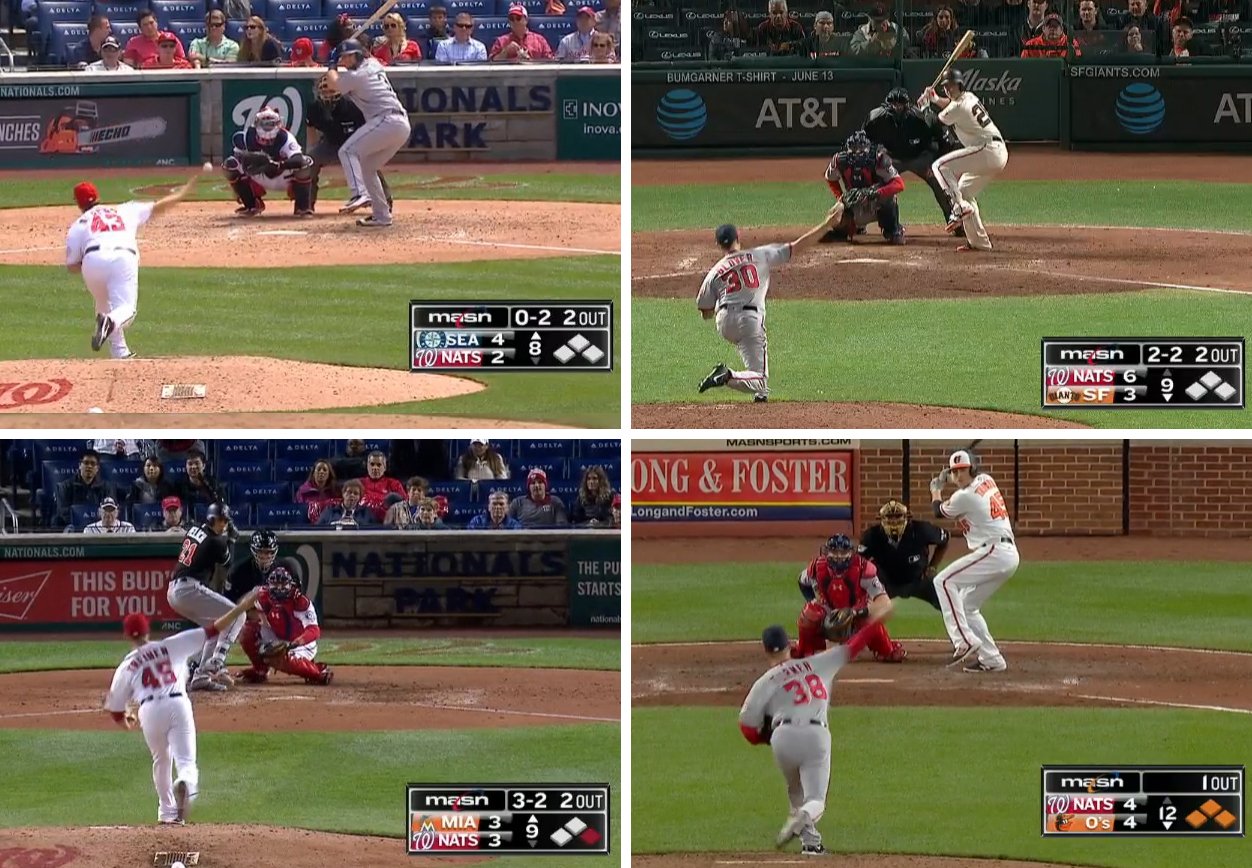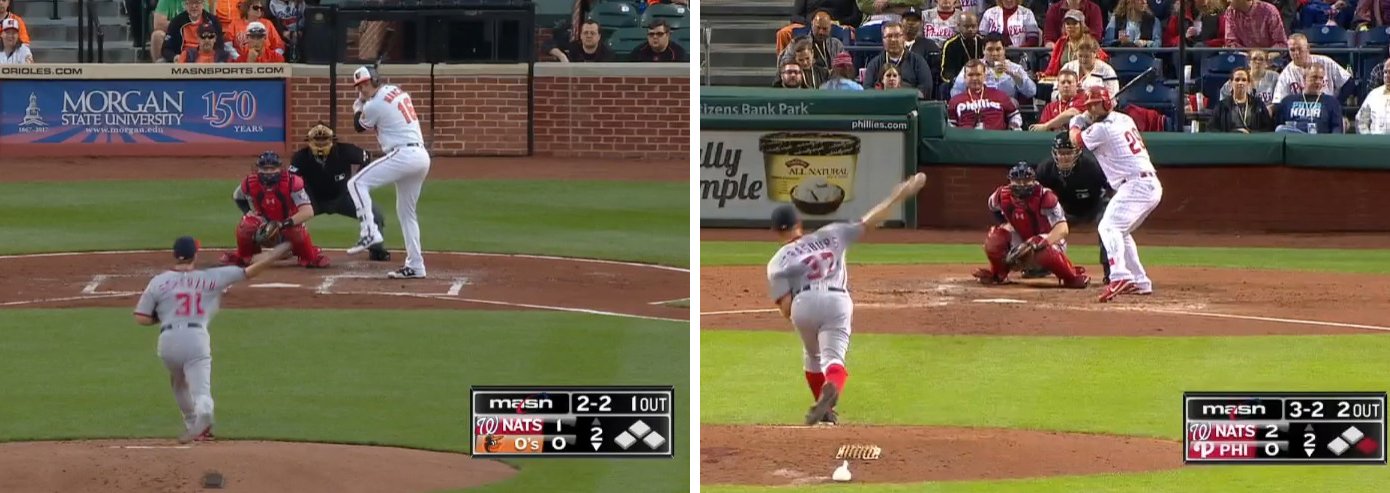WASHINGTON — It’s not revelatory to anyone who has been watching the Washington Nationals play that their relief unit could use some assistance.
Let’s start with the good news. The bullpen’s Fielding Independent Pitching (FIP) is 4.52, lower than its ERA, and its 4.27 Expected Fielding Independent Pitching (xFIP) lower than that. The unit’s Batting Average on Balls in Play (BABIP) was as high as .324 a week or two ago — the worst in the league at the time — and is still third-worst at .317. All of this is to say that there’s likely some measure of pure old bad luck that helps account for the general, ongoing disaster that the relief corps has been this year.
However, even with a better series in San Francisco, Washington still ranks last in the National League in bullpen ERA at 4.82 (77 ER/143.2 IP) as a unit. According to FanGraphs’ measure of Wins Above Replacement — or how many more wins the bullpen has been worth than if you swapped the whole thing out for a bunch of minor leaguers — it has been worth -0.1 wins this season.
This is a problem that stretches beyond the simple concept of a need for a closer. The club likely needs multiple upgrades and they shouldn’t wait to make them. Washington’s starters are throwing the most pitches in the league, threatening to hurt them later in the season as innings mount on tired arms. Their bullpen has thrown the least innings of any unit in baseball, more than 10 fewer innings than the next closest club.
But figuring out what those upgrades look like should mean taking a minute to look at what they already have. And what they already have is a stable of relievers who look, to the batter’s eye, very much the same to one another and to the starters that precede them.
Take, for instance, the right-handed relief corps. Here are (clockwise from top left) Matt Albers, Koda Glover, Blake Treinen and Jacob Turner’s arm angles at delivery (click on photos to expand; all screenshots from MLB.com).
Albers is shifted more to the left side of the rubber, but otherwise, these are strikingly analogous looks (Joe Blanton has been excluded, because he is on the DL, but his delivery is also very similar). You’ll note they look awfully similar not just to one another — a low arm slot, approach from the right side of the rubber — but to each of Washington’s top two starters as well (Joe Ross also throws from a comparable arm slot; Tanner Roark is notably more over-the-top).
For generations, managers have staggered their starting rotations between righties and lefties, flamethrowers and soft-tossers, so as to give the opposing team different looks throughout a series. Why should the approach to a bullpen be any different?
If the definition of insanity is doing the same thing over and over again and expecting different results, then what should we call throwing from the same spot, over and over, no matter the reliever, and expecting them not to get hit? Lefties provide a natural counter-punch, but how much intrinsic value is there in having different-looking righties?
The top five bullpens in baseball — the Indians, Dodgers, White Sox, Yankees and Red Sox — all feature dynamic closers. But while the Andrew Millers, Kenley Jansens, David Roberstons, Aroldis Chapmans (Chapmen?) and Craig Kimbrels of the world are in short supply, relievers with different arm angles and release points are everywhere. Or, at least, seemingly everywhere except Washington.
The Houston Astros have one of the top relief units in the league (fourth in bullpen WAR), relying primarily on righties. But their workhorses all have different deliveries and release points.
Here, you see Chris Devenski well off to the left side of the rubber coming nearly over the top, Ken Giles on the right side with a slightly lower arm slot, Luke Gregerson throwing across his body from a three-quarter slot, and Will Harris coming straight downhill from basically the middle of the rubber.
The Red Sox have also put up very good relief numbers and have, perhaps, an even more dramatically different looking set of relievers. Matt Barnes comes straight downhill. Heath Hembree has a lower arm slot and falls off from the left side of the rubber. Joe Kelly comes from a similar angle as Hembree, but right down the middle. And Craig Kimbrel, their closer, drops down low and fires across his body.
Don Mattingly, one of the better hitters of his era, knows a thing or two about facing tough pitching. Here, the Marlins’ manager is talking about Brad Ziegler, a player the Nationals looked at in free agency but didn’t sign. With the Marlins scuffling, he might be available in a trade.
Ziegler is coming off a bad month, but his FIP (3.92) is more indicative than his ballooned ERA (6.65). He’s got a career 2.59 ERA, but is also coming off two straight excellent years, where he allowed just 31 earned runs (and just five homers) in 136 innings pitched.
Ziegler will turn 38 during this year’s postseason, so he’s not getting any younger. But he’s always succeeded with deception, not velocity, mostly created by his unique delivery.
Another potential option is Steve Cishek, who they missed in their recent series against Seattle. Fresh off the disabled list, Cishek is a familiar face for the Nationals, though, having spent the first five-and-a-half years of his career in Miami. With a career ERA and FIP under 3.00, his deceptive submarine delivery is unlike anything Washington pitchers have to offer.
At just $6 million this year, the 30-year-old’s contract is easily affordable.
Toronto’s Joe Smith fits the bill as well, though despite the Blue Jays’ early struggles, they’re still within contact in the AL East and may not be ready to sell. On a single-year deal for just $3 million, he’s blowing away his career high strikeout rate, having punched out 39 in just 25.2 innings.
When Washington had Tyler Clippard, they had a guy with a funky, different delivery to break up the back of the bullpen. They really haven’t had someone in that mold since his departure. Whoever the Nats end up adding, they should look for someone who gives them something different.
The post Why the Nationals’ bullpen needs a new look appeared first on WTOP.





